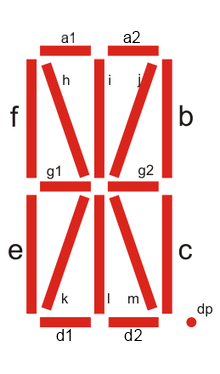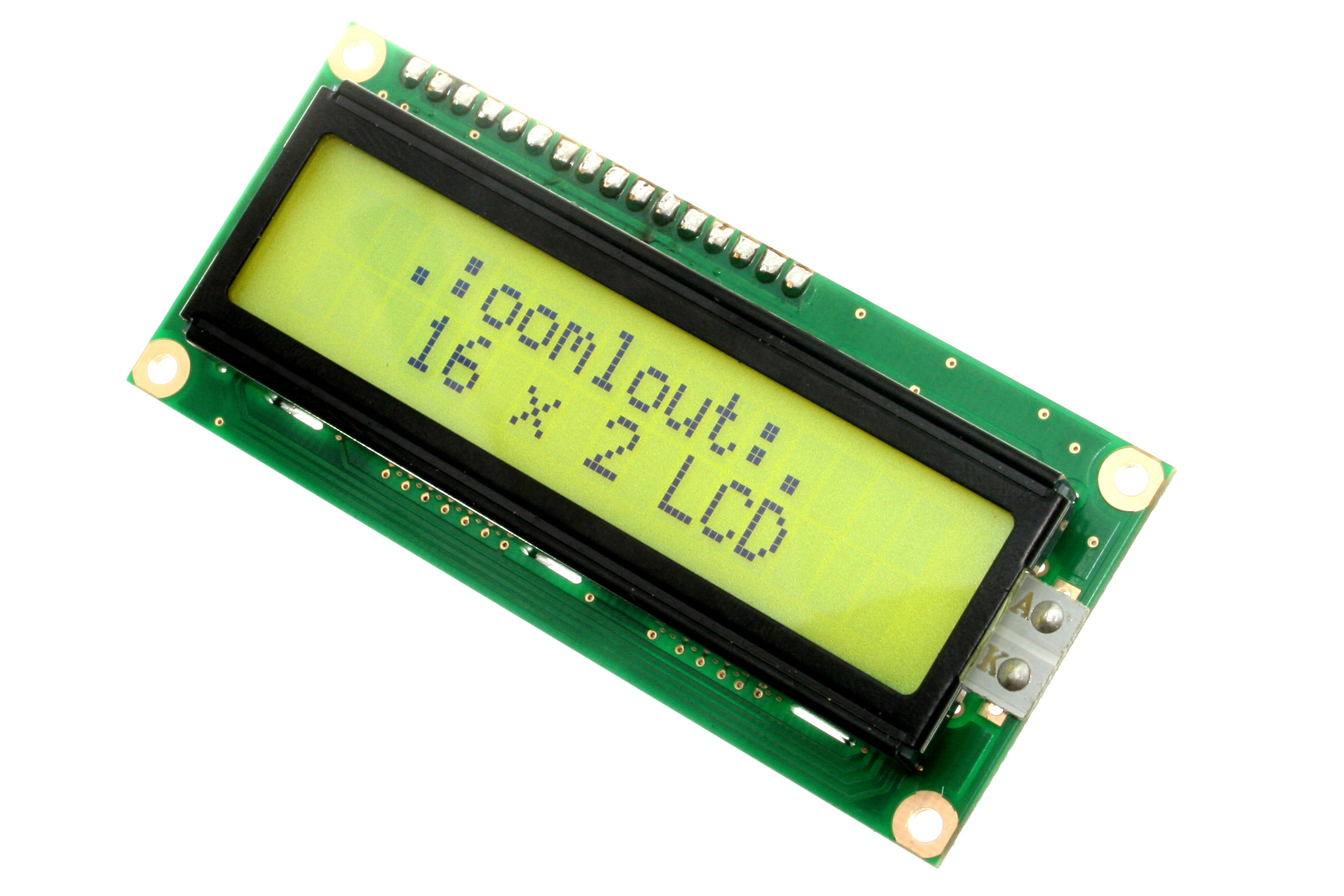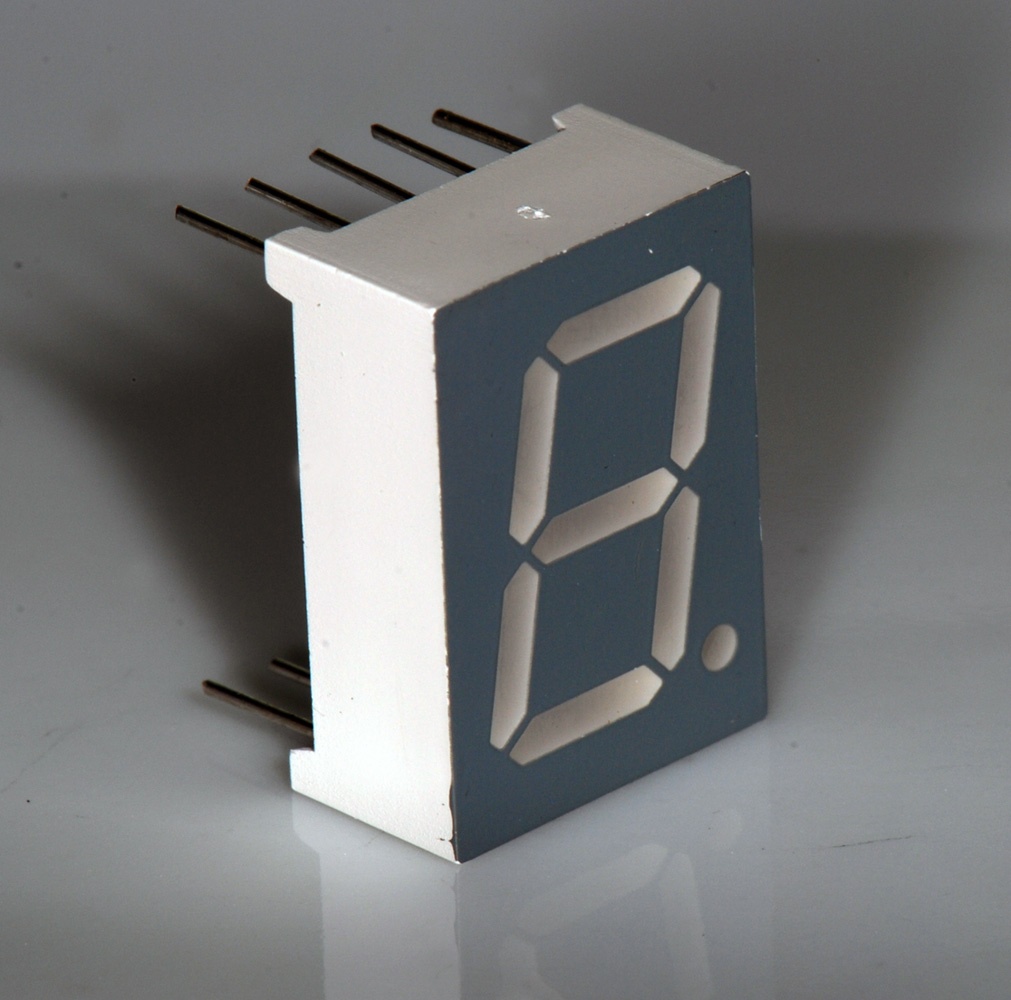|
Sixteen-segment Display
A sixteen-segment display (SISD) is a type of display based on sixteen segments that can be turned on or off to produce a graphic pattern. It is an extension of the more common seven-segment display, adding four diagonal and two vertical segments and splitting the three horizontal segments in half. Other variants include the fourteen-segment display which does not split the top or bottom horizontal segments, and the twenty-two-segment display that allows lower-case characters with descenders. Often a character generator is used to translate 7-bit ASCII character codes to the 16 bits that indicate which of the 16 segments to turn on or off. Applications Sixteen-segment displays were originally designed to display alphanumeric characters (Latin letters and Arabic digits). Later they were used to display Thai numerals and Persian characters. Non-electronic displays using this pattern existed as early as 1902. [...More Info...] [...Related Items...] OR: [Wikipedia] [Google] [Baidu] |
Light-emitting Diode
A light-emitting diode (LED) is a semiconductor device that emits light when current flows through it. Electrons in the semiconductor recombine with electron holes, releasing energy in the form of photons. The color of the light (corresponding to the energy of the photons) is determined by the energy required for electrons to cross the band gap of the semiconductor. White light is obtained by using multiple semiconductors or a layer of light-emitting phosphor on the semiconductor device. Appearing as practical electronic components in 1962, the earliest LEDs emitted low-intensity infrared (IR) light. Infrared LEDs are used in remote-control circuits, such as those used with a wide variety of consumer electronics. The first visible-light LEDs were of low intensity and limited to red. Early LEDs were often used as indicator lamps, replacing small incandescent bulbs, and in seven-segment displays. Later developments produced LEDs available in visible, ultraviolet (UV) ... [...More Info...] [...Related Items...] OR: [Wikipedia] [Google] [Baidu] |
Dot-matrix Display
A dot-matrix display is a low cost electronic digital display device that displays information on machines such as clocks, watches, calculators, and many other devices requiring a simple alphanumeric (and/or graphic) display device of limited resolution. The display consists of a dot matrix of lights or mechanical indicators arranged in a rectangular configuration (other shapes are also possible, although not common) such that by switching on or off selected lights, text or graphics can be displayed. These displays are normally created with LCD, OLED, or LED lights and can be found in some Thin Film Transistors. The Thin Film Transistors had an active display which allows the dot matrix to display different pixels with different colors at the same time. A dot matrix controller converts instructions from a processor into signals that turn on or off indicator elements in the matrix so that the required display is produced. History The dot-matrix display is also called the Pun ... [...More Info...] [...Related Items...] OR: [Wikipedia] [Google] [Baidu] |
Fourteen-segment Display
A fourteen-segment display (FSD) (sometimes referred to as a starburst display or Union Jack display) is a type of display based on 14 segments that can be turned on or off to produce letters and numerals. It is an expansion of the more common seven-segment display, having an additional four diagonal and two vertical segments with the middle horizontal segment broken in half. A seven-segment display suffices for numerals and certain letters, but unambiguously rendering the ISO basic Latin alphabet requires more detail. A slight variation is the sixteen-segment display which allows additional legibility in displaying letters or other symbols. A decimal point or comma may be present as an additional segment, or pair of segments; the comma (used for triple-digit groupings or as a decimal separator in many regions) is commonly formed by combining the decimal point with a closely 'attached' leftwards-descending arc-shaped segment. Electronic alphanumeric displays may use LEDs, ... [...More Info...] [...Related Items...] OR: [Wikipedia] [Google] [Baidu] |
Nine-segment Display
A nine-segment display is a type of display based on nine segments that can be turned on or off according to the graphic pattern to be produced. It is an extension of the more common seven-segment display, having an additional two diagonal or vertical segments (one between the top and the middle, and the other between the bottom and the horizontal segments). It provides an efficient method of displaying alphanumeric characters. The letters displayed by a nine-segment display are not consistently uppercase or lowercase in shape. A common compromise is to use a lower-case "n" instead of "N". Depending on the design of the display segments, the use of the extra two segments may be avoided whenever possible, as in the Nixxo X-Page "tall" lowercase "r" and "y". Perhaps to avoid this awkward inconsistency, the Scope Geo N8T does not allow the use of uppercase or lowercase versions of the letters "J" (even though it could easily be displayed on a 7-segment display). Some other letters li ... [...More Info...] [...Related Items...] OR: [Wikipedia] [Google] [Baidu] |
Eight-segment Display
An eight-segment display is a type of display based on eight segments that can be turned on or off according to the font pattern to be produced. It is similar to a nine-segment display whose middle vertical bars are vertical, except that on an eight-segment display, the bars ''F'' and ''G'' are merged. Applications It was used, for instance, in the calculator Sharp EL-8, producing more rounded digits than a seven-segment display, but fewer possible digits it can display because the bars ''F'' and ''G'' are merged (see table below). Displaying An eight segment display can sometimes display characters with less readability because the segments ''F'' and ''G'' are combined and the corners are rounded. It is unable to display the following characters for this reason: Examples File:Sharp EL-8 The First Portable Electronic Calculator.jpg, Sharp EL-8 with eight-segment displays File:Sharp EL-8 Itron vacuum-fluorescent Display Tube.jpg, Eight-segment display of the Sharp EL-8 File: ... [...More Info...] [...Related Items...] OR: [Wikipedia] [Google] [Baidu] |
Seven-segment Display
A seven-segment display is a form of electronic display device for displaying decimal numerals that is an alternative to the more complex dot matrix displays. Seven-segment displays are widely used in digital clocks, electronic meters, basic calculators, and other electronic devices that display numerical information. History Seven-segment representation of figures can be found in patents as early as 1903 (in ), when Carl Kinsley invented a method of telegraphically transmitting letters and numbers and having them printed on tape in a segmented format. In 1908, F. W. Wood invented an 8-segment display, which displayed the number 4 using a diagonal bar (). In 1910, a seven-segment display illuminated by incandescent bulbs was used on a power-plant boiler room signal panel. They were also used to show the dialed telephone number to operators during the transition from manual to automatic telephone dialing. They did not achieve widespread use until the advent of LEDs in the 1970 ... [...More Info...] [...Related Items...] OR: [Wikipedia] [Google] [Baidu] |
Common Segment Displays
Common may refer to: Places * Common, a townland in County Tyrone, Northern Ireland * Boston Common, a central public park in Boston, Massachusetts * Cambridge Common, common land area in Cambridge, Massachusetts * Clapham Common, originally common land, now a park in London, UK * Common Moss, a townland in County Tyrone, Northern Ireland * Lexington Common, a common land area in Lexington, Massachusetts * Salem Common Historic District, a common land area in Salem, Massachusetts People * Common (rapper) (born 1972), American hip hop artist, actor, and poet * Andrew Ainslie Common (born 1841), English amateur astronomer * Andrew Common (born 1889), British shipping director * John Common, American songwriter, musician and singer * Thomas Common (born 1850), Scottish translator and literary critic Arts, entertainment, and media * ''Common'' (film), a 2014 BBC One film, written by Jimmy McGovern, on the UK's Joint Enterprise Law * Dol Common, a character in ''The Alchemist'' ... [...More Info...] [...Related Items...] OR: [Wikipedia] [Google] [Baidu] |
AIM-65
The Rockwell AIM-65 computer is a development computer introduced in 1978 based on the MOS Technology 6502 microprocessor. The AIM-65 is essentially an expanded KIM-1 computer. Available software included a line-oriented machine code monitor, BASIC interpreter, assembler, Pascal, PL/65, and FORTH development system. Available hardware included a floppy disk controller and a backplane for expansion. Features Rockwell advertised the $375 AIM-65, with 1K RAM, as an "easy, inexpensive omputer... for learning, designing, work or just fun". Standard software included the system console monitor software in ROM, called Advanced Interactive Monitor. It featured an assembler, disassembler, setting and viewing memory and registers, starting execution of other programs and more. Single stepping was made possible using non-maskable interrupt (NMI). The command prompt was the less-than sign "". If the thermal printer was turned on, this would be output on a single line. The monitor incl ... [...More Info...] [...Related Items...] OR: [Wikipedia] [Google] [Baidu] |
Beatmania IIDX
is a series of rhythm video games, that was first introduced by Konami in Japan on February 26, 1999. ''IIDX'' has since spawned 31 arcade releases and 14 console releases on the Sony PlayStation 2. It is the sequel to the ''beatmania'' game series, and part of the Bemani line of music games. A PC release titled ''beatmania IIDX INFINITAS'' has been released, beginning alpha testing in September 2015, and was heavily updated to a new version in 2020. Gameplay Gameplay in general ''Beatmania IIDX'' tasks the player with performing songs through a controller consisting of seven key buttons and a scratchable turntable. Hitting the notes with strong timing increases the score and groove gauge bar, allowing the player to finish the stage. Failing to do so depletes the gauge until it is empty, abruptly ending the song. Starting from '' beatmania IIDX 17 SIRIUS'', two new note types are added. Charge Notes is a note that must be pressed and released on the right time, while Backs ... [...More Info...] [...Related Items...] OR: [Wikipedia] [Google] [Baidu] |
Pinball
Pinball games are a family of games in which a ball is propelled into a specially designed table where it bounces off various obstacles, scoring points either en route or when it comes to rest. Historically the board was studded with nails called 'pins' and had hollows or pockets which scored points if the ball came to rest in them. Today, pinball is most commonly an arcade game in which the ball is fired into a specially designed Arcade cabinet, cabinet known as a pinball machine, hitting various lights, bumpers, ramps, and other targets depending on its design. The game's object is generally to score as many points as possible by hitting these targets and making various shots with #Flippers, flippers before the ball is lost. Most pinball machines use one ball per turn (except during special multi-ball phases), and the game ends when the ball(s) from the last turn are lost. The biggest pinball machine manufacturers historically include Bally Manufacturing, Gottlieb, Williams Ele ... [...More Info...] [...Related Items...] OR: [Wikipedia] [Google] [Baidu] |
Comma
The comma is a punctuation mark that appears in several variants in different languages. It has the same shape as an apostrophe or single closing quotation mark () in many typefaces, but it differs from them in being placed on the baseline of the text. Some typefaces render it as a small line, slightly curved or straight, but inclined from the vertical. Other fonts give it the appearance of a miniature filled-in figure on the baseline. The comma is used in many contexts and languages, mainly to separate parts of a sentence such as clauses, and items in lists mainly when there are three or more items listed. The word ''comma'' comes from the Greek (), which originally meant a cut-off piece, specifically in grammar, a short clause. A comma-shaped mark is used as a diacritic in several writing systems and is considered distinct from the cedilla. In Byzantine and modern copies of Ancient Greek, the " rough" and "smooth breathings" () appear above the letter. In Latvia ... [...More Info...] [...Related Items...] OR: [Wikipedia] [Google] [Baidu] |




